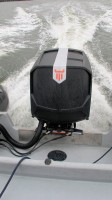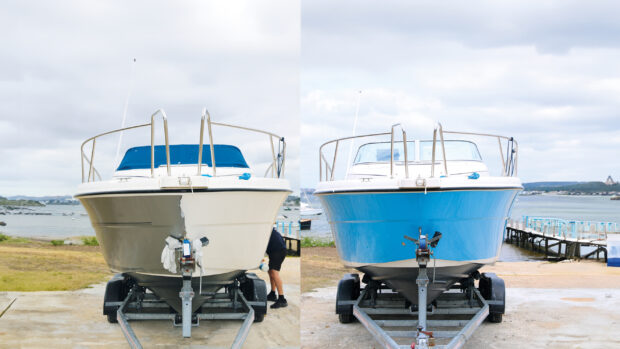The world’s first powerful production diesel outboard has hit the water. Dag Pike takes the Oxe 200hp for a test drive
Defying expectations
The first surprise came on start-up. Most diesel engines sound a bit clattery on start up, at least until they’ve warmed through, but the Oxe sounds smooth and quiet from the off, much like the sound you would expect from a petrol outboard. So far so good, and then I engaged gear.
Again I expected a clunk and a jolt from the drivetrain as the gear slotted home in idle but no, the engagement was smooth and the take-up of power by the propeller equally gentle as the boat moved astern out of the dock.
 There was no discernible smoke and none of the blue haze often associated with diesels; the Oxe meets the latest EPA Tier 3 emission standards for diesels.
There was no discernible smoke and none of the blue haze often associated with diesels; the Oxe meets the latest EPA Tier 3 emission standards for diesels.
This seemed to be a good time to try out the trolling valve system. With the engine revving at its normal idle speed of 650rpm, I engaged the trolling valve and watched the helm display show the propeller turning at just 160rpm for a boat speed of just 2.5 knots.
 You can’t ask for a better low speed control than that if you want to go fishing or perform other delicate manoeuvres.
You can’t ask for a better low speed control than that if you want to go fishing or perform other delicate manoeuvres.
Now for the real test, open the throttles and see how the power comes in. The Oxe diesel engine responded immediately to the throttle commands and I could not sense any of the turbo lag that is often associated with forced induction low capacity diesel engines.
The power simply poured in and in no time we were running at 45 knots and leaving all the sound behind us.
 It was just the performance I would have expected from a petrol outboard of the same power and just as controllable.
It was just the performance I would have expected from a petrol outboard of the same power and just as controllable.
Wind the throttle back to a cruising speed of the mid 30s and some of the sound came back but it still wasn’t intrusive.
The highest compliment I can give this new diesel outboard is that it doesn’t seem any different from a 200hp petrol unit, except that there appears to be more torque at low and mid speed ranges, which could make it particularly suitable for use on a heavier cruising craft.
 Those of you who have a Vauxhall Insignia car will be familiar with the engine.
Those of you who have a Vauxhall Insignia car will be familiar with the engine.
This is the same General Motors 2.0-litre diesel and it runs just as smoothly on the water as it does on the road.
This is a common rail turbo-charged diesel with a closed fresh water cooling system and red-lined at 4,100rpm.
With the hood removed access to most of the important parts is good and Proteum, the British company handling sales in the UK, claims that it needs less frequent servicing than a petrol engine.









